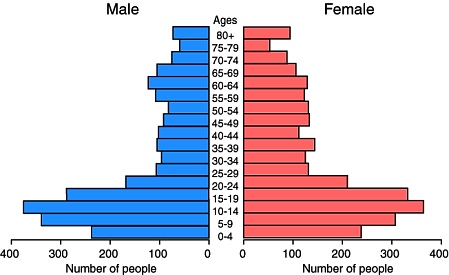The New York City area is now home to over half a million poblanos, natives of the Mexican state of Puebla. A 2005 Smithsonian article by Jonathan Kandell (available here as a pdf file) takes a close look at their expectations and aspirations. Most started as undocumented workers, but many have gained legal status through the 1986 Immigration Reform and Control Act (ICRA) or a variety of other means.
The story of Ricardo and Aldea is just one example. They got to New York by crossing the 49o C (120o F) Sonoran Desert in the summer of 2003. They work 70-hour weeks for less than the minimum wage. She will pay for her month long trip back to Puebla by serving as a courier, or paquetera, a person who carries clothing, electronics, and other gifts from immigrants to their families.
Getting back and forth across the border without proper documents is more difficult than it used to be, but is not a significant problem. Most rely on trusted polleros, often called coyotes, who provide border crossing service for fees ranging from a few hundred dollars for just crossing the border to a few thousand dollars for door-to-door service.
Migration has had a profound impact on villages in Puebla, such as Piaxtla. Most of the 1600 current residents of Piaxtla are either children or elderly (see population pyramid). The mayor claims that “maybe three out of four of my constituents live in New York”. The hundreds of millions of dollars send back each year are having a dramatic effect on rural communities in Puebla. Forty years ago, virtually all the houses were made of palm-thatch adobe. Now they are mostly brick and concrete. Many are topped with satellite dishes.
The towns also have new restaurants, taxis, video arcades, cybercafes, and newly paved streets, all made possible from remittances. Ironically, the towns are sparsely populated and many of the new houses are empty because their owners are working in New York.
Most youth consider the prospect of migration. Few think about careers in Mexico or becoming artisans and continuing Puebla’s long tradition of ceramics, woodworking and weaving. Teenagers show little interest in corn farming, the traditional mainstay of the local economy. In short, migrating to jobs in New York has become the norm.
Somewhat similar migration channels link:
- Aguililla, Michoacán, with Redwood City, California,and
- Napizaro (Michoacan) with North Hollywood (California)
For previous posts about remittances, the funds sent home by migrant workers, see:
- The 10 states in Mexico with the highest percentage of homes receiving remittances
- The 10 states in Mexico receiving the most remittances in total
- The 10 states in Mexico receiving the highest remittances per person
Migration between Mexico and the USA is the focus of chapter 25 of Geo-Mexico: the geography and dynamics of modern Mexico. Ask your library to buy a copy of this handy reference guide to all aspects of Mexico’s geography today! Better yet, order your own copy…

Sorry, the comment form is closed at this time.